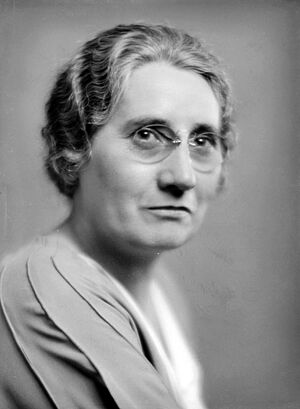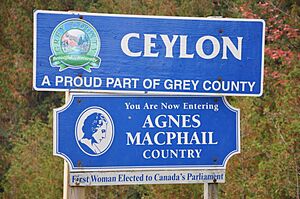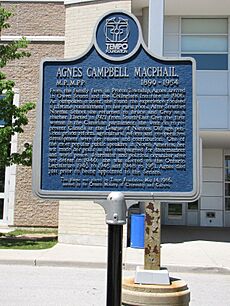Agnes Macphail facts for kids
Quick facts for kids
Agnes Macphail
|
|
|---|---|

Portrait by Yousuf Karsh, 1934
|
|
| Member of Ontario Provincial Parliament | |
| In office 1948–1951 |
|
| Preceded by | John A. Leslie |
| Succeeded by | Hollis Edward Beckett |
| In office 1943–1945 |
|
| Preceded by | George Stewart Henry |
| Succeeded by | John A. Leslie |
| Constituency | York East |
| Member of Parliament for Grey—Bruce |
|
| In office 1935–1940 |
|
| Preceded by | New riding |
| Succeeded by | Walter Harris |
| Member of Parliament for Grey Southeast |
|
| In office 1921–1935 |
|
| Preceded by | Robert James Ball |
| Succeeded by | Riding abolished |
| Personal details | |
| Born |
Agnes Campbell Macphail
March 24, 1890 Proton Township, Grey County, Ontario, Canada |
| Died | February 13, 1954 (aged 63) Toronto, Ontario, Canada |
| Political party | Co-operative Commonwealth Federation, UFO-Labour, Progressive, United Reform Movement |
| Residence | Toronto |
| Occupation | Politician, Journalist, Schoolteacher |
Agnes Campbell Macphail (born March 24, 1890 – died February 13, 1954) was a Canadian politician. She made history as the first woman ever elected to Canada's House of Commons. This is a very important part of the Canadian Parliament.
She served as a Member of Parliament (MP) from 1921 to 1940. Later, she also served in the Legislative Assembly of Ontario from 1943 to 1945 and again from 1948 to 1951. There, she represented the area of York East in Toronto.
Agnes Macphail was always active in politics that aimed to make things better for people. She worked with several political groups, especially the Progressive Party of Canada and the Co-operative Commonwealth Federation. She shared her ideas by writing newspaper columns, organizing groups of activists, and helping to create new laws.
Contents
Early Life and Education
Agnes Macphail was born in Proton Township, Grey County, Ontario. Her parents were Dougald McPhail and Henrietta Campbell. Her family name was originally spelled "McPhail." But later, during a trip to Scotland, she found out her family's original spelling was "Macphail." So, she changed her name to match.
She grew up in the Methodist Church. As a teenager, she joined a different church, the Reorganized Latter Day Saint church, because her uncle was a missionary there. Later in life, she became a member of the United Church of Canada. This church had taken in the Methodist church she knew as a child.
Agnes went to Owen Sound Collegiate and Vocational Institute for one year. Even though she did well, she moved to Stratford Normal School. This allowed her to finish her studies while living with a relative. She graduated in 1910 with a teaching certificate. She applied for five teaching jobs and got all five offers. She later said this was because there weren't many teachers at the time.
She taught in several small schools in Ontario. These included places like Port Elgin, Honeywood, and Newmarket. A local history book says that Agnes Macphail was a teacher at the Gowanlock School. It also mentions she would often debate politics with people at the Burgoyne Store for hours.
While working in Sharon, Agnes became very involved in politics. She joined the United Farmers of Ontario (UFO) and its women's group. Around this time, she also started writing columns for the Farmer's Sun newspaper.
Making History in Federal Politics
After some changes to election laws in 1919, Agnes Macphail ran for office. She was elected to the House of Commons in the 1921 federal election. She represented the area of Grey Southeast for the Progressive Party of Canada. This made her the very first female MP in Canada's history! She was re-elected in 1925, 1926, and 1930.
Agnes Macphail was a strong voice for what she believed in. For example, she spoke out against the Royal Military College of Canada. She felt it was too expensive for some students and taught them to be snobbish. She also believed it was wrong to support a military college because she was a pacifist. This means she was against war and violence.
As a forward-thinking member of the Progressive Party, Macphail joined a group called the Ginger Group. This group later helped create the Co-operative Commonwealth Federation (CCF). She became the first president of the Ontario CCF in 1932. However, she left the CCF in 1934. This happened when the United Farmers of Ontario left the group due to worries about Communist influence. Even though she wasn't officially a CCF member anymore, she stayed close to the CCF MPs. She often joined their meetings. The CCF even chose not to run candidates against her in her next three federal elections.
In the 1935 federal election, Macphail was elected again. This time, she was a United Farmers of Ontario–Labour MP for the new Grey—Bruce area. She was allowed to use the party's name even after it stopped being a political group. She always spoke up for issues important to people living in rural areas.
Agnes Macphail also strongly supported making prisons better. Her efforts helped start an investigation called the Archambault Commission in 1936. The report from this commission led to many improvements in Canadian prisons after World War II. She also cared deeply about women in the justice system. In 1939, she started the Elizabeth Fry Society of Canada. This group helps women who are in trouble with the law. It was named after a British reformer named Elizabeth Fry.
She also fought for things like pensions for seniors and better rights for workers. Agnes Macphail was also the first Canadian woman to be a delegate to the League of Nations in Geneva, Switzerland. There, she worked with the World Disarmament Committee, which aimed to reduce weapons around the world. Even though she was a pacifist, she voted for Canada to join World War II.
In the 1940 election, she lost her seat. But a few days later, a Member of Parliament for Saskatoon City passed away. Agnes Macphail was asked to run in the special election to fill that seat. On August 19, she was defeated by another candidate. This was her last time running in a federal election.
A Voice in Journalism
Agnes Macphail often wrote for newspapers in Grey County. These included the Flesherton Advance and Markdale Standard. She often acted like a reporter or a representative for the rest of the country. She would send updates from Parliament about political news that was important to the rural communities back home. She also wrote columns when she traveled and spoke to people in other regions. She wrote many articles for The Farmer's Sun, a progressive weekly newspaper in Ontario. Some of these articles were memories about the history of rural Ontario.
When she was not in office, she wrote articles about farming for The Globe and Mail newspaper in Toronto. She also wrote about politics for Newmarket Era.
After a sad family event in her hometown, Macphail moved to East York, Ontario, a suburb of Toronto. She rejoined the Ontario CCF in 1942 and became their farm organizer.
Making a Difference in Provincial Politics
In the 1943 provincial election, Agnes Macphail was elected to the Legislative Assembly of Ontario. She became a member of the Ontario CCF, representing the Toronto area of York East. She and Rae Luckock were the first women ever elected to the Ontario Legislature. Agnes was the first woman to be officially sworn in as an Ontario Member of Provincial Parliament (MPP).
She lost her seat in the 1945 provincial election, but she was elected again in 1948. Agnes Macphail was responsible for Ontario's first law about equal pay for equal work, which was passed in 1951. However, she couldn't continue her work because she was defeated in elections later that year. At that time, Macphail had to work hard to support herself by writing, giving speeches, and organizing for the Ontario CCF.
Agnes Macphail really wanted to see more women in politics. She once said, "Most women think politics aren't lady-like. Well, I'm no lady. I'm a human being."
Agnes Macphail never married. She passed away on February 13, 1954, at the age of 63, in Toronto. This was just before she was going to be offered a position in the Senate of Canada. She is buried in Priceville, Ontario, with her parents and one of her two sisters, Gertha Macphail.
Legacy and Recognition
- In 1968, an elementary school in Flesherton, Ontario, was named Macphail Memorial Elementary School in her honor. A new school with the same name was built in 2006.
- In 1981, a public school in Scarborough, Ontario, was also named after her.
- In 1993, to celebrate 50 years since Macphail's election to the Ontario legislature, the mayor of East York declared that March 24 would be known as Agnes Macphail Day every year.
- In 1994, the East York council created the Agnes Macphail Award. This award is given each year to a resident of East York who has made great contributions to equal rights and social justice. It honors someone who has continued Macphail's leadership.
- In 1997, East York started the annual Agnes Macphail public speaking contest for students. There are also several places and projects named after her in East York. These include the Agnes Macphail Parkette, the Agnes Macphail Playground, the Agnes MacPhail Youth Resource Centre, and the Agnes MacPhail Food Bank.
- In 1999, a new housing development named a street after her, Macphail Ave.
- In 2005, in a contest, Agnes Macphail was voted the Greatest Ontario Woman.
- On June 24, 2006, a monument and a bronze statue honoring Agnes Macphail were revealed in Hopeville, Ontario. In the same year, highway signs saying "You are now entering Agnes Macphail Country" were put up near Ceylon and Hopeville. Grey County Road 9 was also named Agnes MacPhail Road.
- An apartment building in Windsor, Ontario, is called "Agnes Macphail Manor."
- A 2015 episode of the TV show Murdoch Mysteries showed a young Agnes Macphail interested in the movement for women's right to vote.
- She appears on the 2017 "Canada 150" edition of the Canadian ten-dollar note. She is the first woman, other than the Queen, to have a permanent spot on Canadian money.
See Also
- List of women in the House of Commons of Canada
- List of women in the Legislative Assembly of Ontario




